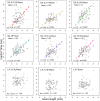Measuring differences in the ERG in myopia using the RETeval device with skin electrodes
- PMID: 39945246
- PMCID: PMC11976514
- DOI: 10.1111/opo.13460
Measuring differences in the ERG in myopia using the RETeval device with skin electrodes
Abstract
Introduction: Previous research suggests that the electroretinogram (ERG) is reduced and delayed in non-pathological myopia. However, the invasive nature of the electrode and cumbersome equipment required has prevented the widescale uptake of ERG measures. This study investigated whether previously reported changes to the ERG response in myopia are also observable when measured using non-invasive skin electrodes and a hand-held ERG device.
Method: Monocular flash ERGs were measured using the RETeval® device according to the 'ISCEV 6 Step Dark First cd' protocol in 46 participants with non-pathological myopia (spherical equivalent refraction [SER] -0.50 to -11.25 D, median -3.75 D, median axial length [AL] 25.4 mm) and 47 non-myopic controls (SER +2.00 to -0.25 D, median +1.00 D, median AL 23.6 mm). Measures were performed under pupil mydriasis with Sensor Strip skin electrodes.
Results: The median implicit time for all dark-adapted (DA) components was longer among myopes. Following Holm-Bonferroni correction, this difference reached statistical significance (p < 0.05) for the DA 3.0 A-wave, DA 10.0 A-wave and B-waves, and DA Oscillatory potentials 1 and 2. There were no significant differences between median light-adapted (LA) implicit times nor response amplitudes between refractive groups. For all DA components, there was a significant, positive correlation between AL and implicit time (all p < 0.05).
Conclusions: The RETeval®, used with skin electrodes, did not detect the reduction in ERG amplitude reported in myopic eyes using traditional ERG setups, potentially due to high inter-subject variability and/or anatomical confounders associated with the use of a skin electrode. The RETeval® with skin electrodes did detect subtle delays to DA implicit times previously reported in myopia, with a positive relationship observed between AL and implicit time for all DA components. In contrast, no significant differences were observed for LA implicit times, which may indicate underlying differences in the dark-adaptation process and/or scotopic visual pathways in myopia.
Keywords: RETeval; electrophysiology; myopia; visual function.
© 2025 The Author(s). Ophthalmic and Physiological Optics published by John Wiley & Sons Ltd on behalf of College of Optometrists.
Conflict of interest statement
LKC Technologies provided a loan of the RETeval device and travel support to Victoria Stapley (VS). This is already included here. Otherwise no author had a conflict of interest.
Figures






Similar articles
-
Evaluation of light- and dark-adapted ERGs using a mydriasis-free, portable system: clinical classifications and normative data.Doc Ophthalmol. 2018 Dec;137(3):169-181. doi: 10.1007/s10633-018-9660-z. Epub 2018 Oct 24. Doc Ophthalmol. 2018. PMID: 30357588
-
Increase in electroretinogram rod-driven peak frequency of oscillatory potentials and dark-adapted responses in a cohort of myopia patients.Doc Ophthalmol. 2020 Apr;140(2):189-199. doi: 10.1007/s10633-019-09732-4. Epub 2019 Oct 28. Doc Ophthalmol. 2020. PMID: 31659575
-
Full-field electroretinogram in autism spectrum disorder.Doc Ophthalmol. 2016 Apr;132(2):83-99. doi: 10.1007/s10633-016-9529-y. Epub 2016 Feb 11. Doc Ophthalmol. 2016. PMID: 26868825
-
Effect of shorter dark adaptation on ISCEV standard DA 0.01 and DA 3 skin ERGs in healthy adults.Doc Ophthalmol. 2016 Aug;133(1):11-9. doi: 10.1007/s10633-016-9554-x. Epub 2016 Jul 9. Doc Ophthalmol. 2016. PMID: 27394667
-
Electroretinogram responses in myopia: a review.Doc Ophthalmol. 2022 Oct;145(2):77-95. doi: 10.1007/s10633-021-09857-5. Epub 2021 Nov 17. Doc Ophthalmol. 2022. PMID: 34787722 Free PMC article. Review.
References
-
- Vitale S, Sperduto RD, Ferris FL. Increased prevalence of myopia in the United States between 1971–1972 and 1999–2004. Arch Ophthalmol. 2009;127:1632–1639. - PubMed
-
- Ueda E, Yasuda M, Fujiwara K, Hashimoto S, Ohno‐Matsui K, Hata J, et al. Trends in the prevalence of myopia and myopic maculopathy in a Japanese population: the Hisayama Study. Invest Ophthalmol Vis Sci. 2019;60:2781–2786. - PubMed
-
- Dong L, Kang YK, Li Y, Wei WB, Jonas JB. Prevalence and time trends of myopia in children and adolescents in China: a systemic review and meta‐analysis. Retina Phila Pa. 2020;40:399–411. - PubMed
MeSH terms
Grants and funding
LinkOut - more resources
Full Text Sources

